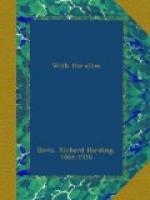Though the humor of troops retreating is an ugly one, I saw no outrages such as I saw in Belgium. Except in the villages of Neuf-chelles and Varreddes, there was no sign of looting or wanton destruction. But in those two villages the interior of every home and shop was completely wrecked. In the other villages the destruction was such as is permitted by the usages of war, such as the blowing up of bridges, the burning of the railroad station, and the cutting of telegraph-wires.
Not until Bouneville, thirty kilometres beyond Meaux, did I catch up with the Allies. There I met some English Tommies who were trying to find their column. They had no knowledge of the French language, or where they were, or where their regiment was, but were quite confident of finding it, and were as cheerful as at manoeuvres. Outside of Chaudun the road was blocked with tirailleurs, Algerians in light-blue Zouave uniforms, and native Turcos from Morocco in khaki, with khaki turbans. They shivered in the autumn sunshine, and were wrapped in burnooses of black and white. They were making a turning movement to attack the German right, and were being hurried forward. They had just driven the German rear-guard out of Chaudun, and said that the fighting was still going on at Soissons. But the only sign I saw of it were two Turcos who had followed the Germans too far. They lay sprawling in the road, and had so lately fallen that their rifles still lay under them. Three miles farther I came upon the advance line of the French army, and for the remainder of the day watched a most remarkable artillery duel, which ended with Soissons in the hands of the Allies.
Soissons is a pretty town of four thousand inhabitants. It is chiefly known for its haricot beans, and since the Romans held it under Caesar it has been besieged many times. Until to-day the Germans had held it for two weeks. In 1870 they bombarded it for four days, and there is, or was, in Soissons, in the Place de la Republique, a monument to those citizens of Soissons whom after that siege the Germans shot. The town lies in the valley of the River Aisne, which is formed by two long ridges running south and north.
The Germans occupied the hills to the south, but when attacked offered only slight resistance and withdrew to the hills opposite. In Soissons they left a rear-guard to protect their supplies, who were destroying all bridges leading into the town. At the time I arrived a force of Turcos had been ordered forward to clean Soissons of the Germans, and the French artillery was endeavoring to disclose their positions on the hills. The loss of the bridges did not embarrass the black men. In rowboats they crossed to Soissons and were warmly greeted. Soissons was drawing no color-line. The Turcos were followed by engineers, who endeavored to repair one bridge and in consequence were heavily shelled with shrapnel, while, with the intent to destroy the road and retard the French advance, the hills where the French had halted were being pounded by German siege-guns.




